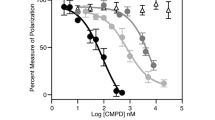Abstract
The retinoblastoma protein (pRB) has the dual capability to negatively regulate both E2F-induced cell cycle entry and E2F1-induced apoptosis. In this report, we characterize a unique pRB–E2F1 interaction. Using mutagenesis to disrupt E2F1 binding, we find that the ability of pRB to regulate E2F1-induced apoptosis is diminished when this interaction is lost. Strikingly, this mutant form of pRB retains the ability to control E2F responsive cell cycle genes and blocks cell proliferation. These functional properties are the reciprocal of a previously described E2F binding mutant of pRB that interacts with E2F1, but lacks the ability to interact with other E2Fs. Our work shows that these distinct interactions allow pRB to separately regulate E2F-induced cell proliferation and apoptosis. This suggests a novel form of regulation whereby separate types of binding contacts between the same types of molecules can confer distinct functional outcomes.
This is a preview of subscription content, access via your institution
Access options
Subscribe to this journal
Receive 50 print issues and online access
$259.00 per year
only $5.18 per issue
Buy this article
- Purchase on Springer Link
- Instant access to full article PDF
Prices may be subject to local taxes which are calculated during checkout







Similar content being viewed by others
References
Dick FA, Dyson N . (2002). Three regions of the pRB pocket domain affect its inactivation by human papillomavirus E7 proteins. J Virol 76: 6224–6234.
Dick FA, Dyson N . (2003). pRB Contains an E2F1 specific binding domain that allows E2F1 induced apoptosis to be regulated separately from other E2F activities. Mol Cell 12: 639–649.
Dick FA, Sailhamer E, Dyson NJ . (2000). Mutagenesis of the pRB pocket domain reveals that cell cycle arrest functions are separable from binding to viral oncoproteins. Mol Cell Biol 20: 3715–3727.
Dyson N . (1998). The regulation of E2F by pRB-family proteins. Genes Dev 12: 2245–2262.
Field SJ, Tsai F-Y, Kuo F, Zubiaga AM, Kaelin WG, Livingston DM et al. (1996). E2F-1 functions in mice to promote apoptosis and suppress proliferation. Cell 85: 549–561.
Ginsberg D . (2002). E2F1 pathways to apoptosis. FEBS Lett 529: 122–125.
Johnson DG, Degregori J . (2006). Putting the oncogenic and tumor suppressive activities of E2F into context. Curr Mol Med 6: 731–738.
Muller H, Bracken AP, Vernell R, Moroni MC, Christians F, Grassilli E et al. (2001). E2Fs regulate the expression of genes involved in differentiation, development, proliferation, and apoptosis. Genes Dev 15: 267–285.
Ren B, Cam H, Takahashi Y, Volkert T, Terragni J, Young RA et al. (2002). E2F integrates cell cycle progression with DNA repair, replication, and G(2)/M checkpoints. Genes Dev 16: 245–256.
Rubin SM, Gall AL, Zheng N, Pavletich NP . (2005). Structure of the Rb C-terminal domain bound to E2F1-DP1: a mechanism for phosphorylation-induced E2F release. Cell 123: 1093–1106.
Stevens C, La Thangue NB . (2003). A new role for E2F-1 in checkpoint control. Cell Cycle 2: 435–437.
Strobeck MW, Fribourg AF, Puga A, Knudsen ES . (2000). Restoration of retinoblastoma mediated signaling to Cdk2 results in cell cycle arrest. Oncogene 19: 1857–1867.
Takahashi Y, Rayman J, Dynlacht B . (2000). Analysis of promoter binding by the E2F and pRB families in vivo: distinct E2F proteins mediate activation and repression. Genes Dev 14: 804–816.
Trimarchi JM, Lees JA . (2002). Sibling rivalry in the E2F family. Nat Rev Mol Cell Biol 3: 11–20.
Urist M, Tanaka T, Poyurovsky MV, Prives C . (2004). p73 induction after DNA damage is regulated by checkpoint kinases Chk1 and Chk2. Genes Dev 18: 3041–3054.
Wells J, Boyd K, Fry C, Bartley S, Farnham P . (2000). Target gene specificity of E2F and pocket protein family members in living cells. Mol Cell Biol 20: 5797–5807.
Acknowledgements
The authors wish to thank numerous colleagues in the London Regional Cancer Program for helpful discussions in the course of this work. The Strategic Training Program in Cancer Research supported LMJ and LAS. LMJ also thanks the Women's Charity Cashspiel and LAS acknowledges support from OGSST. FAD is a Research Scientist of the NCIC/CCS. Funding from the LHRI (IRF-045-03) and an operating grant from the NCIC/CCS (016191) supported this work.
Author information
Authors and Affiliations
Corresponding author
Additional information
Supplementary Information accompanies the paper on the Oncogene website (http://www.nature.com/onc).
Supplementary information
Rights and permissions
About this article
Cite this article
Julian, L., Palander, O., Seifried, L. et al. Characterization of an E2F1-specific binding domain in pRB and its implications for apoptotic regulation. Oncogene 27, 1572–1579 (2008). https://doi.org/10.1038/sj.onc.1210803
Received:
Revised:
Accepted:
Published:
Issue Date:
DOI: https://doi.org/10.1038/sj.onc.1210803



